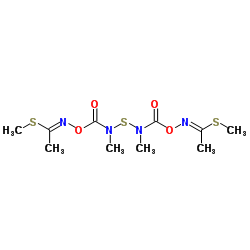59669-26-0
| Name | thiodicarb |
|---|---|
| Synonyms |
semevin
LARVIN SKIPPER CHIPCO NIVRAL dimethyl N,N’-[thiobis[(methylimino)carbonyloxy]]bis[ethanimidothioate] (3EZ,12EZ)-3,7,9,13-tetramethyl-5,11-dioxa-2,8,14-trithia-4,7,9,12-tetraazapentadeca-3,12-diene-6,10-dione lepicron MFCD00145401 Thiodicarb EINECS 261-848-7 |
| Description | Thiodicarb is a carbamate insecticide used to control flies in animal and poultry houses and dairies. Thiodicarb is metabolized into methomyl in animals and plants, and subsequently degraded into carbon dioxide and acetonitrile[1]. |
|---|---|
| Related Catalog | |
| In Vitro | Thiodicarb exhibit both oral and contact activity against major Lepidoptera, Coleoptera, Diptera, and Hemiptera pests, which affect cotton, soya beans, maize, vines, fruit, and vegetables[1]. |
| References |
| Density | 1.3±0.1 g/cm3 |
|---|---|
| Boiling Point | 433.8±28.0 °C at 760 mmHg |
| Melting Point | 168-172°C |
| Molecular Formula | C10H18N4O4S3 |
| Molecular Weight | 354.469 |
| Flash Point | 216.2±24.0 °C |
| Exact Mass | 354.049011 |
| PSA | 159.70000 |
| LogP | 1.52 |
| Vapour Pressure | 0.0±1.0 mmHg at 25°C |
| Index of Refraction | 1.575 |
CHEMICAL IDENTIFICATION
HEALTH HAZARD DATAACUTE TOXICITY DATA
|
| Symbol |


GHS06, GHS09 |
|---|---|
| Signal Word | Danger |
| Hazard Statements | H301-H330-H400 |
| Precautionary Statements | P260-P273-P284-P310 |
| Personal Protective Equipment | Eyeshields;Faceshields;full-face particle respirator type N100 (US);Gloves;respirator cartridge type N100 (US);type P1 (EN143) respirator filter;type P3 (EN 143) respirator cartridges |
| Hazard Codes | T+: Very toxic; |
| Risk Phrases | R25 |
| Safety Phrases | S28-S36/37-S45 |
| RIDADR | 2757 |
| RTECS | KJ4301050 |
| Packaging Group | III |
| Hazard Class | 6.1(b) |


